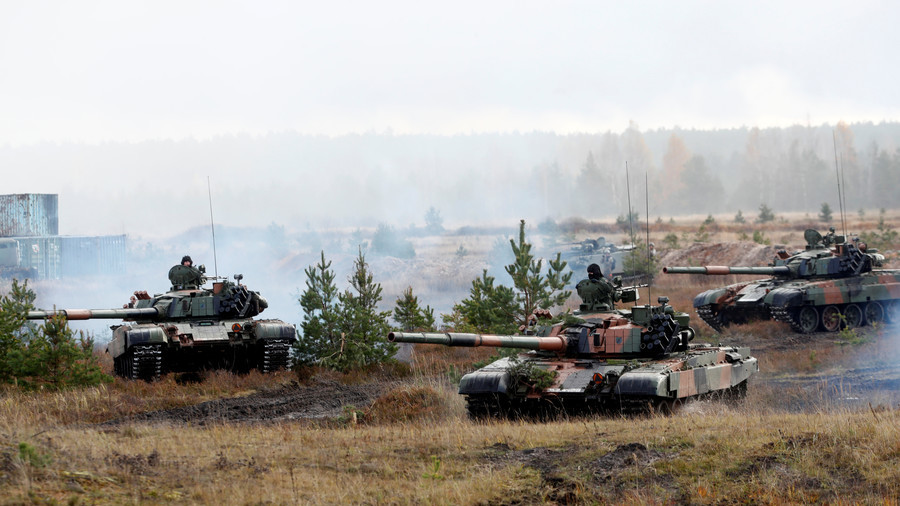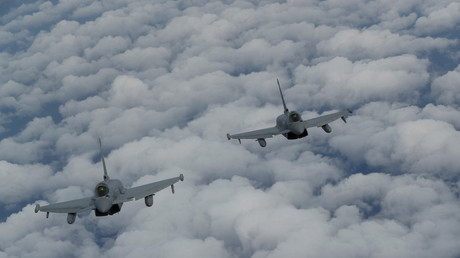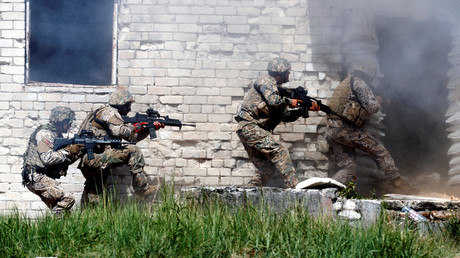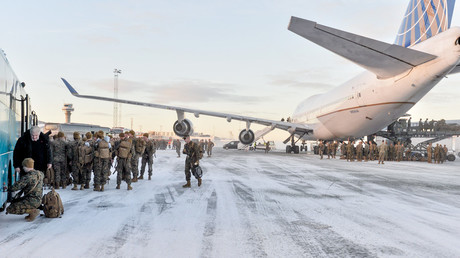‘Our build-up is defensive, Russia’s aggressive,’ says NATO after Putin’s remark – but is that fair?

NATO claims its military buildup in Eastern Europe is justified as it deters Russia’s superior might. Yet, any Russian activity is overshadowed by the US-led bloc’s huge border drills, supposedly held to ‘counter’ Moscow’s moves.
“NATO’s actions are defensive, proportionate and fully in line with our international commitments,” the alliance’s spokeswoman Oana Lungescu told Reuters, commenting on NATO military activities. She further added that the troops deployed by the Alliance to Eastern Europe “cannot compare to the divisions deployed by Russia” on its western borders.
The rant was provoked by the words of Russian President Vladimir Putin, who rebuked NATO for building up its military infrastructure right on Russia’s doorstep. “We do not deploy our military contingents away from our borders and close to the NATO states, it is the NATO infrastructure that advances to our own borders,” Putin told journalists in Sochi.
It was the way this statement was put that apparently made NATO officials so angry that they even de facto claimed that their forces are no match to those of Russia. The comparison is not exactly true, as facts show that NATO’s buildup and military activities near Russian territory actually overshadow the Russian activity.
Less than a week ago, German media reported that Berlin sent as many as 8,000 soldiers and some 100 tanks to Norway in preparation for yet another NATO drill, this time dubbed Trident Juncture 2018 and scheduled for October-November. According to the Alliance, the exercise, which will focus on repelling an aggression of some unfriendly state as part of a collective defense scenario under Article 5 of the NATO treaty, will involve as many as 40,000 participants from more than 30 countries – more than any Russian military exercise conducted in recent years.
The “scariest” Russian war games, dubbed Zapad-2017, which even sparked media-fueled fears that it was a cover for an “invasion” of neighboring countries, involved only 12,700 troops, 70 military aircraft, 10 ships and some 680 ground vehicles. Almost immediately after those drills Poland hosted what it called “national” Dragon 17 exercises, involving contingents from the US, the UK, Germany, Lithuania, Latvia, Slovakia, Italy, Bulgaria, Romania, Georgia and Ukraine. Notably, the number of troops involved in Dragon 17 exceeded those of the Zapad-2017 contingent, with some 17,000 personnel and 3,500 hardware pieces involved.
The US-led bloc continues to intensify its military exercises in Eastern Europe. In less than three months, NATO conducted two major drills in the vicinity of Russian borders. In June, more than 18,000 soldiers from 19 countries took part in the two-week ‘Saber Strike’ exercise, held in Poland and the Baltic States. The drills were said to practice the deployment of military convoys to defend NATO’s eastern flank.
On August 20, Latvia hosted the biggest war games ever staged on its territory since the Baltic State gained independence. Some 10,000 troops from more than a dozen NATO countries are participating in the drills that will end on September 2. However, the military bloc continues to repeat its mantra that all those drills right on Russia’s doorstep are in no way aimed at “provoking” Russia.
As if that was not enough, NATO also beefed up its military contingent in Eastern Europe. In her statement to Reuters, Lungescu only mentioned “4,000 troops to the eastern part of the Alliance to deter any possible aggression” as if those troops were the only ones NATO recently sent to the region. She forgot to note that the US will soon double the number of its Marines stationed in Norway. Also left out were the missile defense installations in Poland and Romania that are equipped with Lockheed Martin Aegis Ashore systems, which are technically capable of carrying both interceptor missiles and Tomahawk missiles.
In October 2017, the US also sent a new mechanized brigade to Poland, effectively increasing the overall strength of its military group in the Eastern European state to the level of a mechanized division. The Russian Defense Ministry spokesman, Major General Igor Konashenkov, said at that time that the equipment of another US brigade, which had previously been stationed there “remained in place.”
He added that such a situation gives the US an opportunity to easily redeploy its trained military personnel from its German Rammstein base to Poland within just two hours. According to the Russian Defense Ministry, NATO has tripled its military presence on Russia’s western borders over the past five years, forcing Moscow to respond.
Meanwhile, Russia has not deployed any significant military forces to its western borders in recent years, except for the stationing of Iskander-M tactical missile systems in its western exclave of Kaliningrad in early 2018. However, it is Russia that NATO and the West so desperately seek to portray as a source of instability in the region. Moscow has repeatedly warned that increased NATO presence on its doorstep effectively contributes nothing to regional security and, to the contrary, undermines stability in Europe.




0 Comments:
Post a Comment
Subscribe to Post Comments [Atom]
<< Home